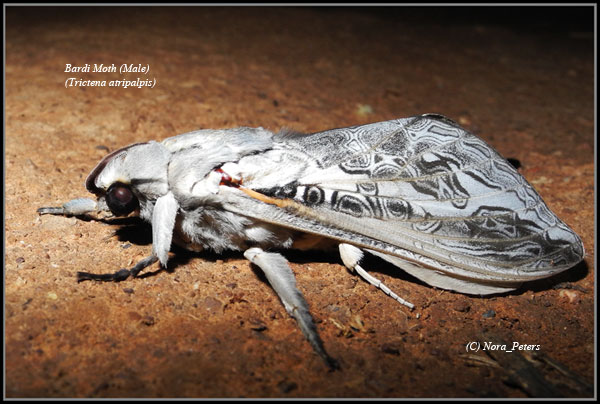Cinnamon Fungus (Phytophthora cinnomonia)
The Cinnamon Fungus has the ability to rot the roots of grasstrees causing them to die. It's impact on the Xanthorrhoea Johnsonii variety is unknown and seems to be more significant for species outside of Queensland, Australia, although further investigation is required according to Borsboom (2005).
Beetles
Beetles often sit on the flowering spikes and lay eggs producing larvae that starts to eat away at the spikes usually from the bottom up (from our observation) although this can occur anywhere on the plant. It doesn't kill the plant, and many of these stalks still end up throwing viable seeds if the spikes are long enough. We have observed that smaller stalks do tend to get dessimated by this beetle larvae.
Birds like cockatoos like to eat these larvae but we don't have birds like that on Meyrik Farm. You can generally detect these larvae by observing a lump at the bottom of the flowering spike with a browny-grainy substance and resin. The resin is produced by the grass plant as a self-defence mechanism in an attempt to trap the grub and stop it from moving further up the spike. Sometimes this succeeds and sometimes it doesn't.

We have started to scrape the brown substance and resin off the stalks to see if we can stop the grubs early on before creating too much devastation. We have found grubs trapped in resin, but also sometimes as many as 6 grubs on one spike that you only see when you start digging. They usually start in the stalk first and move up the spike in a spiral fassion.
According to Bruinsma Grasstrees it may also be best to cut off the flower spike below the level of the grubs to protect the tree from damage.
Scale
According to the Department of Primary Industries and Regional Development scale insects are sap-suckers which usually start on the leaf for feeding. They tend to be immobile and not move around a lot, intsead staying in one spot whilst feeding and building up their protective covers. This can eventually kill the plant if left untreated.
Mealybugs
Mealybugs generally thrive in temperatures above 25 degrees C and high humidity according to the Department of Primary Industries and Regional Development. Mealybugs typically search for sheltered areas on the grasstree after hatching to feed off and tend to reach peek levels during spring and autumn.

Bardi Grubs
Bardi grubs are from larvae of the Longicorn beetle (Bardistus cibarius) according to the Department of Primary Industries and Regional Development which tends to thrive in grasstrees with thick skirts. The female moth lays eggs into the foliage and the grubs from the eggs then bore into the fibrous centre of the tree which disrupts the plant's ability to carry water and nutrients to the crown of the plant.
This may lead to the tree rotting and falling over.
Burning off of grasstree leaves may prevent this from happening.
Meyriccia latro Moth
Larvae from the Meyriccia latro moth can eat the seeds of grassplants. The moths tends to lay its eggs on the spikes when they are immature and when hatched eat away at the small black seed once the seed pod opens.
This is less likely to happen to grasstrees that flower early in the season.
Cows
Not sure if this is considered a natural threat, but our friendly neighbour has cows that have traditionally ventured onto our property. The previous owners didn't mind, but we noticed that our grass plants had very shortened leaves.
After observing and seeing the cows in action we noticed that they rip the leaves from the centre which we believe is not good for the plants (although we don't have any longterm evidence of this). We have also seen the cows breaking the stalks on grass trees and eating the flowering spikes before they have time to seed.
For this reason we put up an electric fence around the farm, but since then our friendly farmer neighbour has relocated his cows to a different paddock.
Possums
Possums (Trichosurus vulpecula) have been reported to chew on the young flower spikes similar to cows, and the weight of possums usually break the spike. Even though it won't kill the plant it does stops the grasstree from seeding.
According to studies possum damage to flower spikes is estimated to be around 14%.
Too Much Phosphorous
Xanthorrhoea plants will die if given too much phosphorous-containing fertilizers. They do well on seaweed-containing fertilizers such as seasol.
Removal from Natural Environment
Grasstrees do not like being removed from their natural environment and rarely survive. According to Phil Watson from Australian Plants Online transplanting grasstrees requires a lot of diligence with heavy equipment needed to extract roots and soil. "Flooding the root zone helps maintain an intact root system and digging the new sites hole prior to the arrival, followed by deep watering of the plant's roots zone, aids the chances of survival".
Neither us or Phil recommend digging up existing plants.
Too Much Fire
Frequent fire can cause significant deaths in Xanthorrhoea species in general. Xanthorrhoea Johnsonii is very tolerant to fire, but more studies are needed to determine whether it is also susceptible to too much burning off according to Borsboom (2005).







